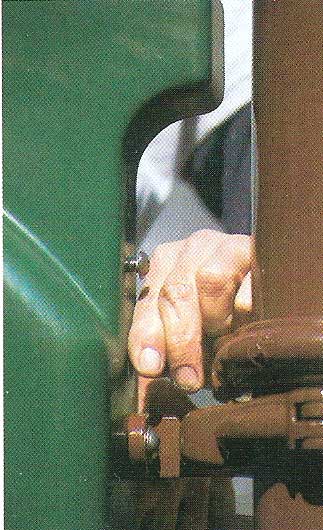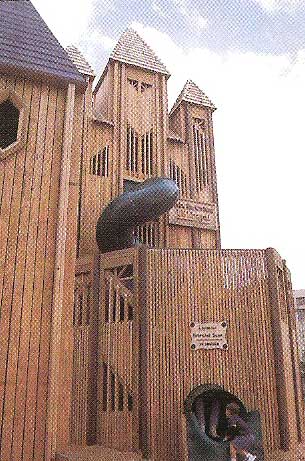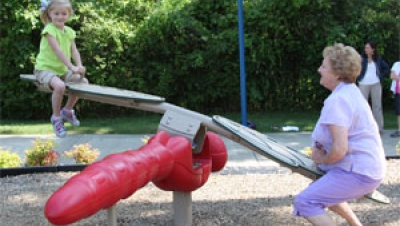Volunteers are turning out in record number to build new playgrounds, but is community-built always a good idea?
When constructing the U.S. Constitution, the Founding Fathers put an awful lot of thought into the first 10 amendments that would collectively become known as the Bill of Rights. Freedom of speech and freedom of religion topped the list, while the right to bear arms and the right to a speedy and public trial were also included.
Darrell Hammond, however, believes in a right that went unmentioned.
''People don't recognize play as an absolute child's right," says the CEO and co-founder of KaBOOM! "A lot of people actually think it's a luxury.
"They don't recognize play as being as important as having bathrooms in school, yet we send kids to school without either having recess in the school day or no playground there. Could you imagine sending your kid to a school without a bathroom? I mean, you could make that analogy. It's the same thing as sending a kid to a school without a playground.

"Our first mission is to raise the awareness of the child's right to play, the need for play, and the need for places to play."
In order to bring more playgrounds to more kids, Hammond and Dawn Hutchison created KaBOOM! in 1996. Over the last five years, their organization has helped coordinate the construction of more than 240 playgrounds by virtue of a process that Hammond calls "very organized chaos." After an initial visit to determine what kind of playground a specific community or school needs and wants, representatives from KaBOOM! return a couple of months later to lead a corps of volunteers numbering anywhere from 15 to 800. Work usually begins around 7 or 8 a.m., and most playgrounds are all but installed in four to six hours.
" Building a playground is just like baking a cake," Hammond says. "You just need to break it down for people. What do I do first? What do I do next? When do I put it in the oven" What temperature do I put it in the oven? How long do I put it in the oven? "And then it comes out
just right."
Of course, it's said that too many cooks can spoil the soup. So can too many inexperienced and untrained installers spoil the playground cake?
CREATING COOPERATION
Don't get Barry Segal started. Project manager, designer and community organizer for Leathers & Associates, Segal has been with the Ithaca, N.Y.-based company for "20 years, 60 days and 22 hours."
After a moment he adds, "Of course, I did it for five years as a hobby, so 25 years total. I came here as a carpenter with a degree in parks and recreation and I had some architectural training. I think this is what I was born for."
And what he lives for. Although he was contacted at a quarter to five late on a Friday afternoon, Segal didn't let the call of the weekend pry him away from his favorite subject. "One time after a build in an inner-city area, this little kid came up and asked, 'Can I play on this?' He just couldn't believe that he had this beautiful new playground practically in his own backyard.
Unlike KaBOOM! built playgrounds, Leathers Structures are constructed almost entirely of wood purchased from the local lumber company and are essentially built from scratch. They are all unique in design, and some may take up as much space as a football field. Because of their size and the materials used, Leathers' playgrounds require anywhere from five days to four weeks to construct. At one particularly mammoth project in Lake Charles, La., Segal estimates that 200 volunteers worked three shifts a day for 10 days.
"That's 24,000 man hours," he declares after checking his math three times. "It's pretty amazing."
And for Segal, the process is just as amazing as the playgrounds that end up being built. Leathers purposely tries to pair volunteers up together who may be from vastly different walks of life - the senior citizen with the tattooed and pierced teenager - in order to create opportunities for new friendships and greater understanding. The playground builds might also include "ordinary moms and dads" working alongside work-release prisoners.
"The first day they come out, some don't get involved and just keep their hands in their pockets," Segal says of the prisoners. " But the second day they come out they become workers, and by the third day they become captains. They move from being incarcerated to workers to friends, and by the fourth day they may not only be friends, but employees.


"I've seen that. A prisoner may be working alongside someone who owns a company who says, 'After you get out, I'll give you a job."
Certainly no one would argue that the community built process brings out the best in people. It gives many folks an easy introduction to volunteerism, and helps pull people together an age when they can go from home to work to home without ever speaking to a neighbor. In addition to providing a new playground in an area of great need with little
money, it can give that a community a sense of pride and shared ownership. And it also provides them with a place to renew the new friendships and acquaintances they made during the process.
"What we've found is that the playground becomes like a town square," Hammond says. “Much like the town square in old-town America, the playground is now the place where everybody can congregate and kids can play safely."
Of course, with the creation of so many new standards and guidelines over the past decade, playground safety has become just as important as the playground itself. So while no one would argue that the community-built process is good for both the kids and the community, there are concerns over how builds are undertaken.
“Community-built playground can offer an opportunity for neighborhoods or even entire communities to unite together for the common cause of their children,” says Monty Christiansen, Associate Professor of Recreation and Parks at Penn State University. “ This can foster a wonderful sense of community oneness, cooperation and pride.
”But it is essential that any volunteer build be very carefully and skillfully organized and managed under the direction of professional builders with experience in playground development. Otherwise the possibility of well-meaning but unskillful volunteer construction efforts could result in either unfortunate injuries to workers and improper installation of playground equipment, perhaps creating a hazardous condition, or both.”
Safety Vs. Saving Money
Not everyone comes out ahead on community-built playgrounds. In most cases, the entire process is essentially set in motion to avoid having to pay a professional playground contractor to install the equipment. While it’s understandable that a playground owner/operator would want to circumnavigate these fees, it’s also understandable that a professional installer would feel a bit cheated.
“For me personally, I don’t like community-built because I don’t believe that the people out there know what they're doing.” says Curtis Stoddard, chairman of the National Playground Contractors Association. “ These rules that I learned, not everyone knows them. It’s not common knowledge… There’s a lot of rules and regulations, and rules and regulations are not a place for volunteers.
“By the same token, I know that if the principal and the parents didn’t go out and volunteer to build that playground, the kids wouldn’t have a playground to play on and so it’s kind of Catch-22.”
Officially, Stoddard says the NPCA’s stand on community-built playground is this: “there should be someone in charge that’s licensed, insured and certified.
“Insured means that you have insurance if someone gets hurt while you’re building the playground or after you've built it. Licensed means that you have any licenses required
by the state, county or city. And certified means certified by NPSI or certified with manufacturer to install their playgrounds.
"If somebody wants to do that and then use volunteers to build playgrounds, then it's OK with the NPCA."
At KaBOOM!, which has had the benefit of gleaning years of experience from older community-built companies such as Leathers & Associates and Learning Structures, most of the project managers are NPSI certified. In addition, at least one sales representative from the manufacturer is present at every build, and since KaBOOM! currently uses only Playworld Systems equipment, all of the project managers have been to the factory and essentially certified to install Playworld structures. Following the construction, the sales rep then goes over everything once more to make certain the components were properly installed.
"As a general rule, I think KaBOOM! is very careful that standards and guidelines are being followed," says Dr. Donna Thompson, director of the National Program for Playground Safety. "The manufacturer is involved in the community-built process, and I'm sure that
they make every effort to make sure that things are being done properly."
At Leathers' builds, where the playground may require the use of enough lumber to frame five homes, the key to quality control is "small bites." Volunteers may be instructed in how to do just one particular task such as drilling a hole, putting screws in or sanding. But like the army, the key to success is in having good officers; the Leathers project managers will train anywhere from one to 30 captains, and those captains will in turn train anywhere from 50 to 1,600 people. In addition, the captains are required to be motivators, transfer information and oversee quality control.
As for the project managers, Segal says every project manager at Leathers & Associates is NPSI certified, some are on the ASTM committee and they have one person whose primary
specialty is the Americans with Disabilities Act compliance.
"We design in safety, we design in accessibility, and in the field we make sure that it's built properly," Segal says. "And when it's all over, we do a final inspection. Then, the day after it's completed, we come back fresh the next morning and do a real detailed inspection."
Brett Haddaway, president of Progressive Playgrounds Inc. in Califon, N.J., has personally supervised over 400 community-built playgrounds over the last 15 years, and has been involved in the construction and design of more than 1,200. "And I've worked with anywhere from two volunteers to 300, so I've seen just about everything that you can come across in community-built playgrounds," he says.
Like Leathers playgrounds, Progressive's structures are unique, often designed to reflect something from the community. Unlike Leathers, however, the playground components are constructed by Henderson Recreation Equipment in Ontario, Canada, then shipped to Progressive in form of a hardware kit to be assembled at the site.
"Everything is cut and drilled and marked, so it's just a matter of installation," Haddaway says. " It's a lot easier. You don't need the quantity of volunteers or the skill level that you would for a Leathers playground.”
Although Progressive has its own installation crews, Haddaway says that they try to lobby their customers for community-built so they can purchase more equipment. As for the issue of safety surrounding volunteer builds, he believes there’s nothing to worry about: “I feel that it’s safer than having a contractor put it in. Depending on the size of the project, you may have 15 to 50 people looking for things that are wrong because they have a vested interest in the project/ It’s their kids that will be playing on it, so they want to make sure that it’s done right. A contractor, though, is out there trying to throw it in as fast as possible, trying to get the thing done and make as much money as possible.
“It’s not uncommon for us to have to send our crew our to bail out a contractor, but it’s rare that we have to go back on a community-built playground.”
Most safety experts and educators would disagree that community-built, and many said that they had witnessed things at volunteer builds that were not consistent with current standards and guidelines. There are also those that have concerns about the sargey of the volunteers during the construction process.
“You've got a lot of people in a construction zone who aren’t used to being in a construction zone,” points out Ken Kutska, Superintendent of Parks and Planning for the Wheaton (Ill.) Park District. “There’s 50 or 100 people on the work site without a knowledge of what’s going on. It’s an accident ready to happen.”
As Stoddard pointed out, that’s what makes an understanding of insurance so important at a community build. Not only should the project managers be aware of who is liable were an accident to occur, but the volunteers should also be informed of who is at risk from a liability standpoint in the event of an injury. There’s also the question of local and state regulations. Some states such as Nevada have laws in place that make it difficult for a community build to legally come together , while others like Wyoming have no laws that would prohibit the process.
“The animosity for community-built playgrounds comes from two places,” Stoddard says. “It comes from the educators who are concerned that the safety guidelines aren't being followed because the volunteers don’t know what they’re doing. And it comes from the construction people who build playground because volunteers are out there doing it and they’re not paying for insurance and licenses and overtime and trucks.”
Stoddard also believes that community-built playgrounds are becoming more prevalent because manufacturers and sales representatives want to keep a bigger share of the financial pie. "
“Say a person has $10,000 to spend. The company's getting $7,500 of it, and the installer's getting $2,500. The manufacturer wants more of that, and the way to get more of that is to get volunteers to do the work."




MAINTAINING THE DREAM
Although there are different opinions about the benefits and/or limitations of community-built playgrounds, everyone in the industry seems to be in agreement about one thing: post-build maintenance is a major problem.
During the build, volunteers catch the fever. And when they leave after the ribbon cutting, they go home feeling good about themselves and their community. But how many are willing to go back to that playground every week and make sure that the surfacing material is still up to standard? How many are willing to put forth the money to have a NPSI inspector come by every couple of months for an inspection and/or audit?

"Regardless of who designed, manufactured or installed the equipment, or who developed the playground, it is also essential that a good maintenance program be developed, financed and implemented," Christiansen says. "Community-built playgrounds, when provided with these quality controls and not just as a one-time, volunteer work weekend festival' can provide fun, safe play spaces for children."
Unfortunately, many people who get involved in playground builds are oblivious to the fact that they require further attention once the components are installed. And if they are aware, there's likely to be some confusion over whose responsibility it will be to keep everything up to code.
"When is a donation really a donation?" Kutska says. "You always have to ask yourself, Are there any hidden strings there I'm not aware of? Who's going to be left holding the bag?
"Politically it's hard to say no. Someone will always say, 'It will be great for public relations,' and everyone will get a good, warm feeling inside. But once it's done, a lot of those people will leave and won't be back. But there's maintenance that needs to be done and new parts that need to be bought when they break."

Segal says that Leathers & Associates does its best to make post-build maintenance an issue right from the start of the project. Much like the idea behind the Adopt a Highway program, the company tries to create a Friends of the Park organization to look out for the playground after it's completed.
"There's nothing worse than a non-maintained playground," Segal says. "I mean, if you have 300 people running through your house everyday it would require some maintenance, so playgrounds certainly need to be maintained. But whether it's a company built or a community-built, it can be kept safe over time if you set up a maintenance program and establish a maintenance fund.
Of course, there have also been many post-build success stories. Most community-built advocates believe that because a community built the playground itself that it develops a sense of ownership and will go to greater lengths to make sure that it's properly maintained. Hammond tells the story of a KaBOOM! playground in Philadelphia that was vandalized on its one-year anniversary. Among other things, the steel posts were dented by baseball bats and the playground was spray painted.

"It hit the morning news before everyone got up, and by the end of the day the playground was cleaned up, scrubbed down and touched up with paint," Hammond says. "A contracting company had saw what happened and said, 'We're not going to let these people demoralize our spirit. We're going to clean it up as fast as they built it."'


A SATISFYING PROCESS
Although Stoddard says, "I believe that they're taking money out of my pocket," he also believes that there is a place in the world for community-built playgrounds.
"Volunteerism is good in America, especially now in the 2000s. America was built on 'go help your neighbor - go help him put up a barn.' And now everyone's afraid to go help their neighbor. And this gives them a chance to do something.
"And they do it because it's for the kids, and that's good."

Sometimes it's hard to tell who gets more out of a community-built playground, the children who play on it or the adults who banded together to install it. The volunteers walk away with a feeling of pride, satisfaction and unity, while the build coordinators and managers have their spirits refreshed practically every day.
"The actual construction event is what keeps me in the business," Haddaway declares. "That's where I get the most joy from, seeing all kinds of people from different backgrounds get excited about turning a flat field into a beautiful structure in just one or two days. It's personally and professionally very satisfying to be involved in that process."

And making sure that process is safe for the, volunteers involved and creates a safe playground for the children who will play on it is the best way to keep everyone satisfied.




















Add new comment